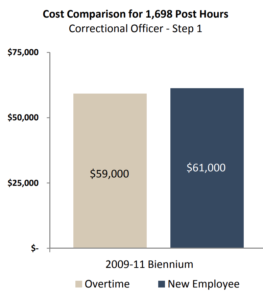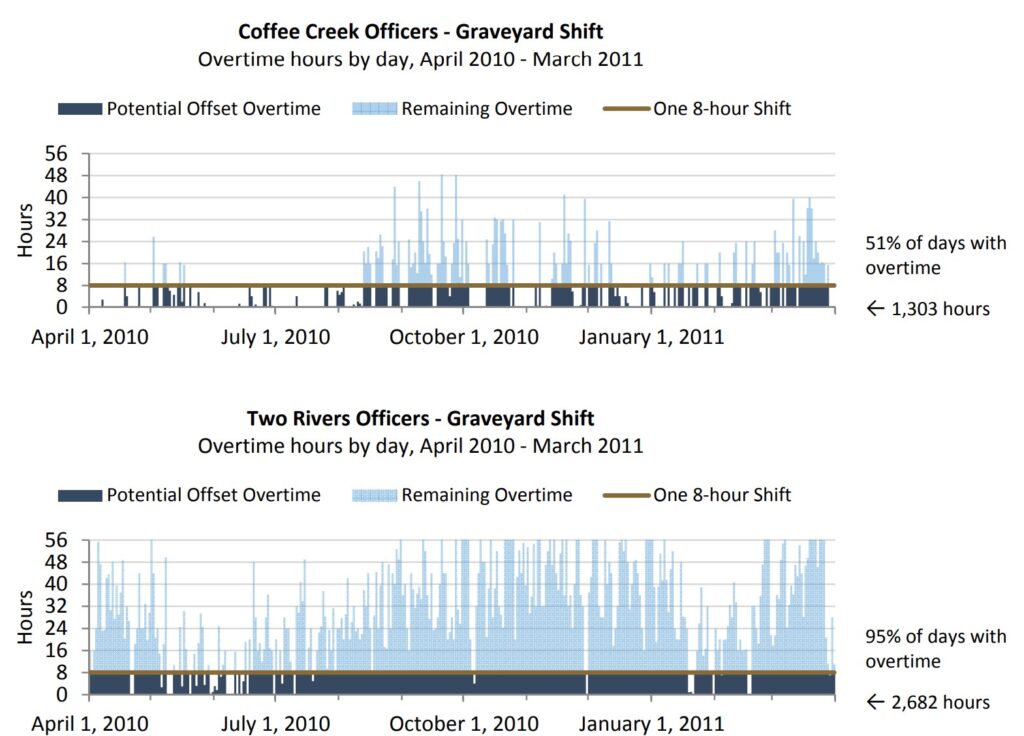This story begins before I was an auditor. I worked in the Planning and Research section of the sheriff’s office and during my time a charter change transferred jail responsibilities back to the sheriff where they had historically been.
We were asked to prepare the budget of the jails and embarked on research to understand its spending. Overtime was a point of contention for the commissioners, who now, at last, expected the sheriff to get overtime spending under control. Several times in the past, they had approved the conversion of overtime money into additional positions with the promise that no more would be spent on overtime. Overtime was still being spent, and more requested, and commissioners would not be deceived again.
I learned about posts and absence rates, and the concept of post staffing. I read what research literature I could find, yet it didn’t answer the question of why a jail could be staffed at the proper-sized workforce but still need overtime. Everything was built on averages: average vacation rate, sick leave rate, injury leave, number of vacancies, and so forth. The world has more variability than averages, which explained overtime. There were some days in the winter when two officers were down with the flu, two might be off on injuries—all added to three vacant positions waiting for new hires. When multiple absences coincide, more overtime is needed. A binomial distribution helped visualize the range of absences experienced in the sheriff’s office. While that might have been clear, why hadn’t the past increase of corrections officers been a solution?
To hire enough corrections officers for all the peaks of absences would also result in many idle hours of surplus corrections officers when absences were low. Overtime made perfect sense to cover the peaks of absences, but where should the line be drawn to determine the correct number of officers? This was weighed against the cost of hiring an additional officer who would be absent many hours in the first year while undergoing the months of mandatory training, and also absent every year due to vacation and sick leave. I suggested the sheriff set limits on some absences, like training and vacations, spreading them out through the year. There would still be bumps in overtime for the absences that couldn’t be controlled, like injuries and illness.
My analysis identified the least-cost mix of staffing and overtime, which the sheriff used to justify an overtime budget and staffing level for the commissioners. I was in a courthouse elevator on the way to a hearing and was introduced to one of the commissioner’s staffers. When I offered to sit down and discuss my analysis, they responded, “Just more of the sheriff’s bullshit.” The sheriff lacked the support of at least one commissioner, but was apparently still able to get three votes for the budget.
A decade later, when I was county auditor, we audited sheriff’s overtime. Craig, was a staff auditor who could methodically work through the most complex problems, and one of the few CPAs I ever encountered who could easily move between performance and financial issues. He dove into the topic and produced a great in-depth analysis in the report, better than I had ever done, complete with recommendations to better control the manageable absences. With increased health care costs, the balance started to shift and the difference between full-time and overtime staffing came closer. New hires need the extra training, and even though they might not earn as much vacation time, the inflation of health benefits raised the costs of an added hire to near-parity with overtime. Vacancies create savings that nearly offset overtime costs. Craig pointed out that the distinction between overtime and straight time in personnel costs was less important than looking at the costs collectively.
When I was at the state we looked at overtime costs in the prison system. I put two members of my audit team, Amelia and Ian, in contact with Craig and, with richer state data and the advances in data analysis, they were able to dive into deeper research and portray the issues with more robust graphs. Rather than try to write the audit for the general public, I urged them to go into the detail necessary—full wonk mode—and to rely on a short, simple summary for the public. They found that the difference in cost between a full-time position and overtime hiring had narrowed further, as shown in the chart to the left.

They devised the impressive charts below. Though the charts take a bit of thought, they produce a visual “Aha!” moment. The vertical bars show the number of overtime hours by day. Staffing with the equivalent of one extra corrections officer all 365 days a year would avoid some of the overtime, represented by the darker base of those hours. At Coffee Creek, hiring one more officer would save 1,303 hours, but for many days that officer would not be needed. In contrast, one additional corrections officer at Two Rivers would avoid 2,682 hours. The corrections officer would be needed nearly every day, which can be seen with the uniformly dark blue band at the bottom.

| Department of Corrections: Managing Security Personnel Costs, p. 22 |
We found the prisons were doing a relatively good job of balancing personnel and overtime with the resources they had, and noted ways to collect better data. Unfortunately, the department had set a hierarchy of causes and was assigning a cause such as sick leave or vacation leave to each overtime hire. This ran counter to the idea that a coincidence of several absences was the cause, and choosing one of them was arbitrary and misleading. I think our case convinced the corrections analysts, but not the managers. However, I’ve learned that an idea can take time to catch hold in an organization.
